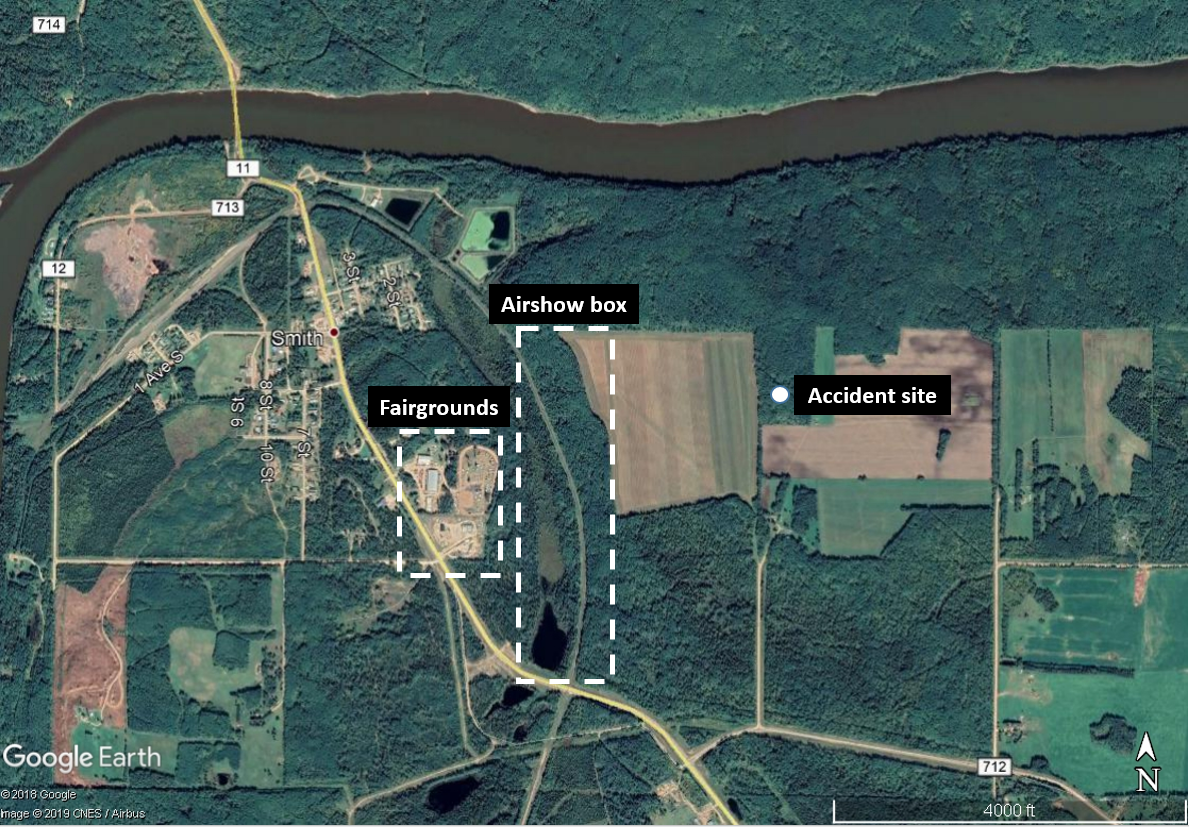Collision with terrain
Nanchang CJ6A
Smith, Alberta
The occurrence
On , at approximately 1130 Mountain Daylight Time, a privately registered Nanchang CJ6A aircraft (registration C-FTGZ, serial number 1532014) departed a privately owned grass airfield located 7 nautical miles (NM) south of Smith, Alberta, to participate in an airshow at the fairgrounds in Smith.
A special flight operations certificate (SFOC) was issued by Transport Canada for a 2-aircraft airshow to be conducted at the 2019 Smith Hondo Fall Fair. The occurrence aircraft was one of the 2 aircraft authorized. The investigation determined that the airshow was performed in accordance with the limitations and requirements of the SFOC.
The airshow concluded at 1207 as the aircraft completed its final south-to-north pass through the airshow box (Figure 1). As the aircraft departed the airshow box, it made a right turn to the east. At 1208, the aircraft was observed doing a rolling manoeuvre and impacted the ground in a wooded area, approximately 1 NM east of Smith, at 55°9.731' N and 114°0.853' W. The pilot, the sole occupant of the aircraft, was fatally injured.
The aerodrome routine meteorological report (METAR) issued at 1200 for Slave Lake (CYZH), Alberta, indicated the following:
- calm winds
- visibility 9 statute miles
- no clouds
- temperature 15 °C
Weather was not considered a factor in this accident.
The 121.5 MHz emergency locator transmitter (ELT) was found intact and was manually switched off by first responder personnel. The expiry date for the ELT battery was February 2020. The ELT had last been serviced in June 2018.
The occurrence aircraft was equipped with a Garmin GPSMAP 196 global positioning system (GPS), which was recovered at the accident site and sent to the TSB Engineering Laboratory, in Ottawa, Ontario, for analysis. Flight data was recovered from the GPS. The recorded parameters included universal date and time, elevation, latitude and longitude position, and ground speed. The data for the occurrence flight spanned about 44 minutes. The final recorded GPS data point before impact indicated that the aircraft was at an altitude of 2636 feet above sea level (541 feet above ground level), at 118 mph ground speed.
The aircraft impact attitude was approximately 65° nose-down and wings-level. The aircraft was destroyed on impact. All major components of the aircraft were accounted for at the accident site. The nature of the impact was not survivable. The flight control systems, engine, propeller, and flight instruments that were examined did not exhibit any failures that would have prevented normal operation.
According to the records reviewed, the aircraft was certified and maintained in accordance with the existing regulations, and the aircraft was being operated within the weight and balance design limits.
The pilot held a commercial pilot licence – aeroplane rated for single- and multi-engine land- and seaplanes, and a Category 1 medical certificate, both valid until 01 November 2019.
The pilot’s flight hours at the time of the accident are unknown, because his personal log was not up to date. At 23 May 2016, the pilot had 4006.8 hours total flight time recorded in his log, and the pilot flew the occurrence aircraft for the first time on 06 October 2017. Since the aircraft was purchased, 60.9 hours had been flown on the occurrence aircraft, but it is unknown how many of those hours were flown by the pilot.
Media materials
Deployment notice
TSB deploys a team of investigators following an accident in Smith, Alberta
Edmonton, Alberta, 1 September, 2019 – The Transportation Safety Board of Canada (TSB) is deploying a team of investigators following a fatal accident involving a Nanchang CJ-6A aircraft that occurred in Smith, Alberta, yesterday. The TSB will gather information and assess the occurrence.
Investigation information
Download high-resolution photos from the TSB Flickr page.
Class of investigation
This is a class 5 investigation. Class 5 investigations are limited to collecting data, which are then stored in the modal database. If TSB investigators deployed to the occurrence site, a short description of the occurrence is posted to the TSB website once the investigation has been completed. These investigations are generally completed within 90 days. For more information, see the Policy on Occurrence Classification.
TSB investigation process
There are 3 phases to a TSB investigation
- Field phase: a team of investigators examines the occurrence site and wreckage, interviews witnesses and collects pertinent information.
- Examination and analysis phase: the TSB reviews pertinent records, tests components of the wreckage in the lab, determines the sequence of events and identifies safety deficiencies. When safety deficiencies are suspected or confirmed, the TSB advises the appropriate authority without waiting until publication of the final report.
- Report phase: a confidential draft report is approved by the Board and sent to persons and corporations who are directly concerned by the report. They then have the opportunity to dispute or correct information they believe to be incorrect. The Board considers all representations before approving the final report, which is subsequently released to the public.
For more information, see our Investigation process page.
The TSB is an independent agency that investigates air, marine, pipeline, and rail transportation occurrences. Its sole aim is the advancement of transportation safety. It is not the function of the Board to assign fault or determine civil or criminal liability.
